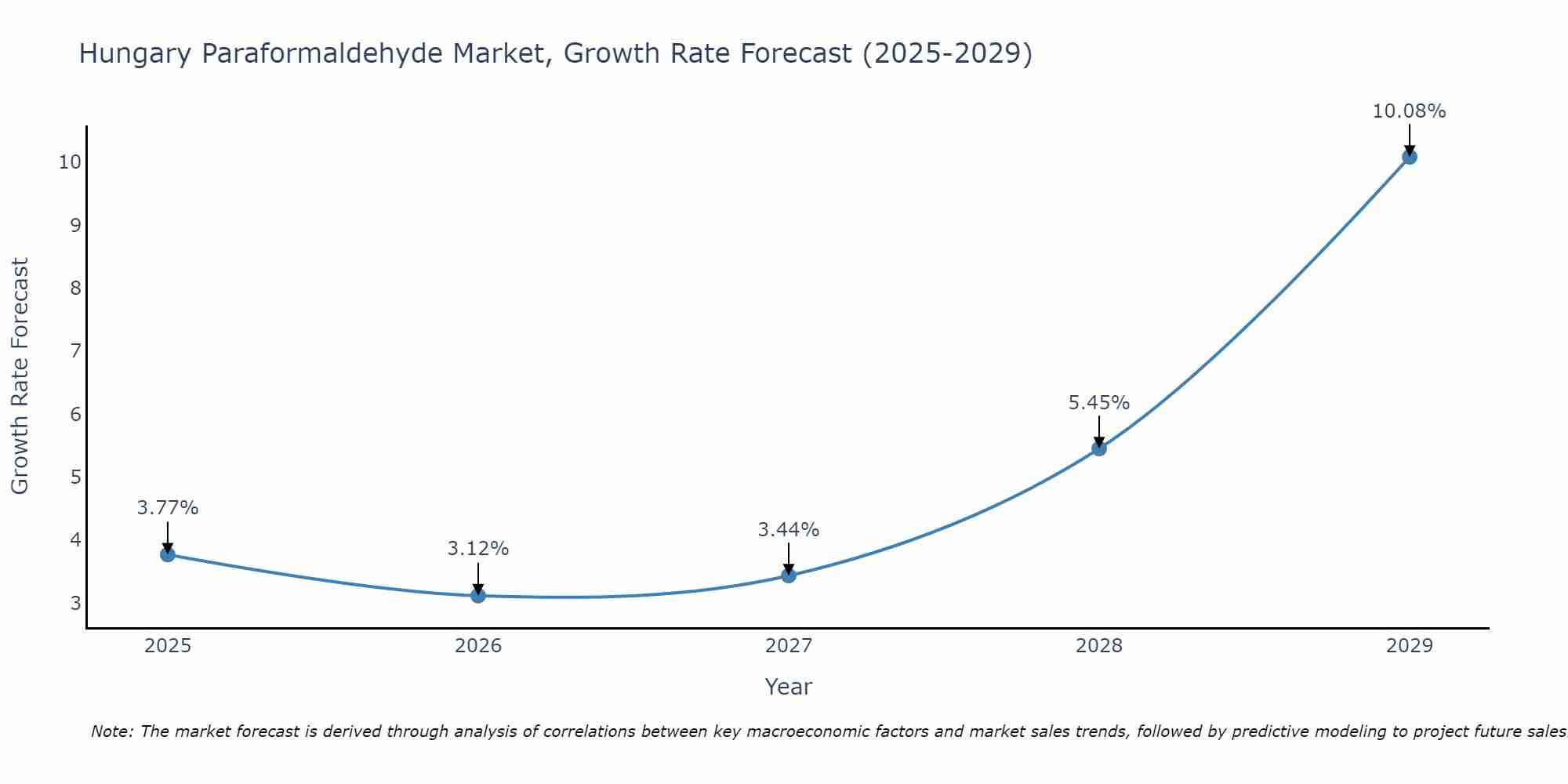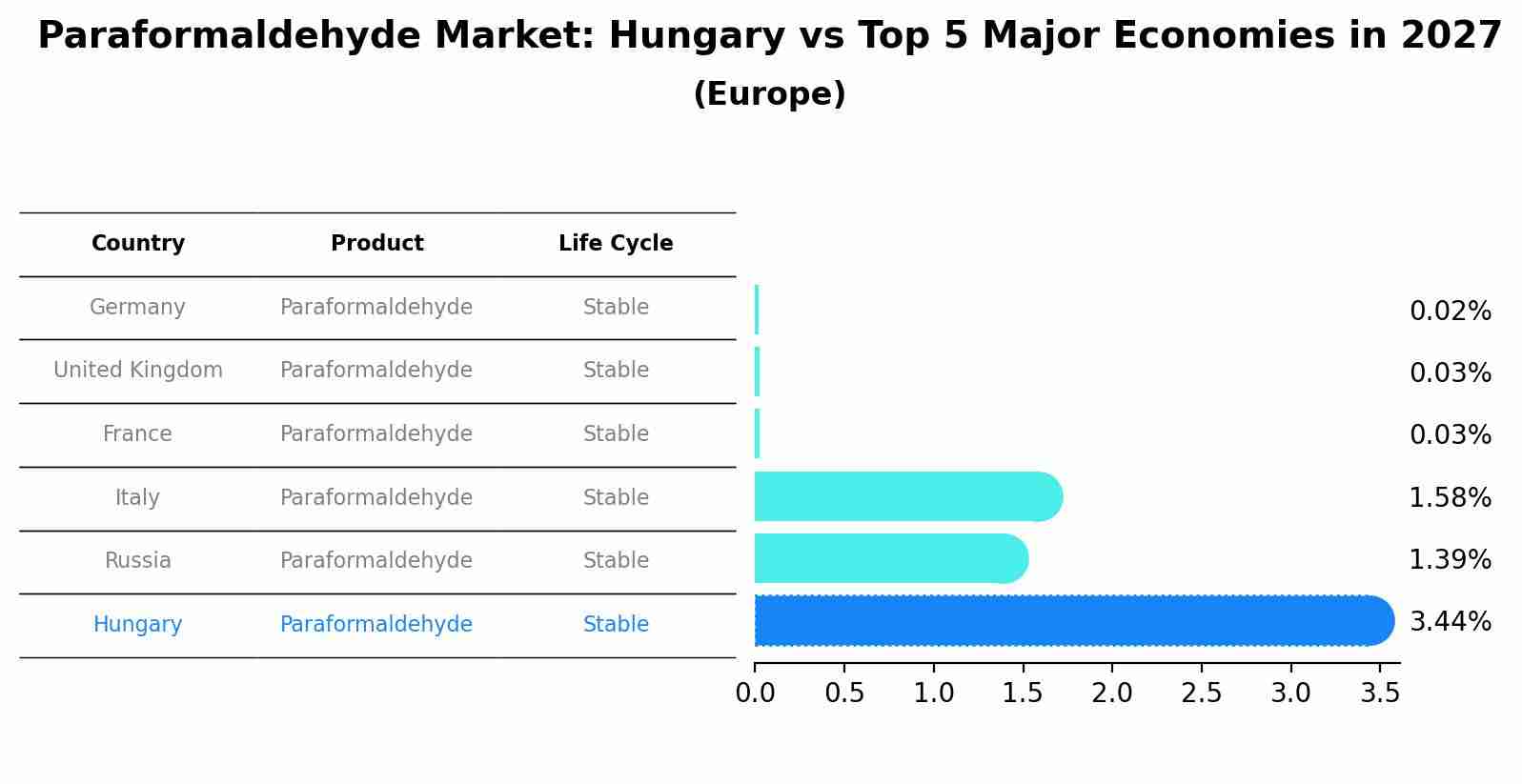Hungary Paraformaldehyde Market Outlook | Industry, Analysis, Forecast, Share, Revenue, Trends, COVID-19 IMPACT, Value, Growth, Companies & Size
| Product Code: ETC337519 | Publication Date: Aug 2022 | Updated Date: Aug 2025 | Product Type: Market Research Report | |
| Publisher: 6Wresearch | Author: Ravi Bhandari | No. of Pages: 75 | No. of Figures: 35 | No. of Tables: 20 |
Hungary Paraformaldehyde Market Size Growth Rate
The Hungary Paraformaldehyde Market is projected to witness mixed growth rate patterns during 2025 to 2029. Commencing at 3.77% in 2025, growth builds up to 10.08% by 2029.

Paraformaldehyde Market: Hungary vs Top 5 Major Economies in 2027 (Europe)
By 2027, Hungary's Paraformaldehyde market is forecasted to achieve a stable growth rate of 3.44%, with Germany leading the Europe region, followed by United Kingdom, France, Italy and Russia.

Hungary Paraformaldehyde Market Overview
In Hungary, the paraformaldehyde market is experiencing steady growth, propelled by its extensive usage in various applications such as agrochemicals, pharmaceuticals, and resin production. Paraformaldehyde, as a solid form of formaldehyde, finds widespread application as a disinfectant, fungicide, and intermediate in the synthesis of various chemicals. The market is characterized by stringent regulatory frameworks concerning product safety and environmental impact.
Drivers of the market
In Hungary, the paraformaldehyde market is primarily driven by its extensive use as a key raw material in the production of resins, adhesives, and various chemical intermediates. The market growth is also supported by the increasing demand from sectors like automotive, construction, and pharmaceuticals.
Challenges of the market
The paraformaldehyde market in Hungary confronts several challenges that impede its development and profitability. One major challenge is the stringent regulations and safety standards governing the production and use of paraformaldehyde due to its toxic nature. Compliance with these regulations requires significant investment in equipment and processes to ensure worker safety and environmental protection. Additionally, fluctuating raw material prices, particularly formaldehyde, which is a key precursor in paraformaldehyde production, pose challenges for cost management and pricing strategies. Furthermore, competition from alternative resins and substitutes adds pressure on market players to innovate and differentiate their products to maintain market share.
Government Policy of the market
The Hungary government implements policies to regulate the production, handling, and use of paraformaldehyde to protect public health and the environment. These policies may include licensing requirements for manufacturers, safety regulations for handling and transportation, and restrictions on the sale and distribution of paraformaldehyde-containing products. Additionally, the government may promote research and development efforts to find alternative chemicals or processes that are safer and more sustainable.
Key Highlights of the Report:
- Hungary Paraformaldehyde Market Outlook
- Market Size of Hungary Paraformaldehyde Market, 2021
- Forecast of Hungary Paraformaldehyde Market, 2028
- Historical Data and Forecast of Hungary Paraformaldehyde Revenues & Volume for the Period 2018 - 2028
- Hungary Paraformaldehyde Market Trend Evolution
- Hungary Paraformaldehyde Market Drivers and Challenges
- Hungary Paraformaldehyde Price Trends
- Hungary Paraformaldehyde Porter's Five Forces
- Hungary Paraformaldehyde Industry Life Cycle
- Historical Data and Forecast of Hungary Paraformaldehyde Market Revenues & Volume By Application for the Period 2018 - 2028
- Historical Data and Forecast of Hungary Paraformaldehyde Market Revenues & Volume By Resins for the Period 2018 - 2028
- Historical Data and Forecast of Hungary Paraformaldehyde Market Revenues & Volume By Agrochemicals for the Period 2018 - 2028
- Historical Data and Forecast of Hungary Paraformaldehyde Market Revenues & Volume By Medical Applications for the Period 2018 - 2028
- Historical Data and Forecast of Hungary Paraformaldehyde Market Revenues & Volume By Others for the Period 2018 - 2028
- Hungary Paraformaldehyde Import Export Trade Statistics
- Market Opportunity Assessment By Application
- Hungary Paraformaldehyde Top Companies Market Share
- Hungary Paraformaldehyde Competitive Benchmarking By Technical and Operational Parameters
- Hungary Paraformaldehyde Company Profiles
- Hungary Paraformaldehyde Key Strategic Recommendations
Frequently Asked Questions About the Market Study (FAQs):
1 Executive Summary |
2 Introduction |
2.1 Key Highlights of the Report |
2.2 Report Description |
2.3 Market Scope & Segmentation |
2.4 Research Methodology |
2.5 Assumptions |
3 Hungary Paraformaldehyde Market Overview |
3.1 Hungary Country Macro Economic Indicators |
3.2 Hungary Paraformaldehyde Market Revenues & Volume, 2021 & 2028F |
3.3 Hungary Paraformaldehyde Market - Industry Life Cycle |
3.4 Hungary Paraformaldehyde Market - Porter's Five Forces |
3.5 Hungary Paraformaldehyde Market Revenues & Volume Share, By Application, 2021 & 2028F |
4 Hungary Paraformaldehyde Market Dynamics |
4.1 Impact Analysis |
4.2 Market Drivers |
4.2.1 Increasing demand for paraformaldehyde in the pharmaceutical industry for drug manufacturing |
4.2.2 Growing applications of paraformaldehyde in the production of resins, adhesives, and coatings |
4.2.3 Rising adoption of paraformaldehyde in the agriculture sector for crop protection and preservation purposes |
4.3 Market Restraints |
4.3.1 Fluctuating prices of raw materials used in paraformaldehyde production |
4.3.2 Stringent regulations and environmental concerns regarding the use of paraformaldehyde |
4.3.3 Competition from alternative products and substitutes impacting market growth |
5 Hungary Paraformaldehyde Market Trends |
6 Hungary Paraformaldehyde Market, By Types |
6.1 Hungary Paraformaldehyde Market, By Application |
6.1.1 Overview and Analysis |
6.1.2 Hungary Paraformaldehyde Market Revenues & Volume, By Application, 2018 - 2028F |
6.1.3 Hungary Paraformaldehyde Market Revenues & Volume, By Resins, 2018 - 2028F |
6.1.4 Hungary Paraformaldehyde Market Revenues & Volume, By Agrochemicals, 2018 - 2028F |
6.1.5 Hungary Paraformaldehyde Market Revenues & Volume, By Medical Applications, 2018 - 2028F |
6.1.6 Hungary Paraformaldehyde Market Revenues & Volume, By Others, 2018 - 2028F |
7 Hungary Paraformaldehyde Market Import-Export Trade Statistics |
7.1 Hungary Paraformaldehyde Market Export to Major Countries |
7.2 Hungary Paraformaldehyde Market Imports from Major Countries |
8 Hungary Paraformaldehyde Market Key Performance Indicators |
8.1 Research and development investment in paraformaldehyde technologies |
8.2 Adoption rate of paraformaldehyde in emerging applications |
8.3 Number of partnerships and collaborations for expanding market presence |
8.4 Environmental sustainability initiatives and certifications in paraformaldehyde production |
8.5 Innovation and product differentiation in paraformaldehyde offerings |
9 Hungary Paraformaldehyde Market - Opportunity Assessment |
9.1 Hungary Paraformaldehyde Market Opportunity Assessment, By Application, 2021 & 2028F |
10 Hungary Paraformaldehyde Market - Competitive Landscape |
10.1 Hungary Paraformaldehyde Market Revenue Share, By Companies, 2021 |
10.2 Hungary Paraformaldehyde Market Competitive Benchmarking, By Operating and Technical Parameters |
11 Company Profiles |
12 Recommendations |
13 Disclaimer |
- Single User License$ 1,995
- Department License$ 2,400
- Site License$ 3,120
- Global License$ 3,795
Search
Thought Leadership and Analyst Meet
Our Clients
Related Reports
- Canada Oil and Gas Market (2026-2032) | Share, Segmentation, Value, Industry, Trends, Forecast, Analysis, Size & Revenue, Growth, Competitive Landscape, Outlook, Companies
- Germany Breakfast Food Market (2026-2032) | Industry, Share, Growth, Size, Companies, Value, Analysis, Revenue, Trends, Forecast & Outlook
- Australia Briquette Market (2025-2031) | Growth, Size, Revenue, Forecast, Analysis, Trends, Value, Share, Industry & Companies
- Vietnam System Integrator Market (2025-2031) | Size, Companies, Analysis, Industry, Value, Forecast, Growth, Trends, Revenue & Share
- ASEAN and Thailand Brain Health Supplements Market (2025-2031) | Strategy, Consumer Insights, Analysis, Investment Trends, Opportunities, Growth, Size, Share, Industry, Revenue, Segments, Value, Segmentation, Supply, Forecast, Restraints, Outlook, Competition, Drivers, Trends, Demand, Pricing Analysis, Competitive, Strategic Insights, Companies, Challenges
- ASEAN Bearings Market (2025-2031) | Strategy, Consumer Insights, Analysis, Investment Trends, Opportunities, Growth, Size, Share, Industry, Revenue, Segments, Value, Segmentation, Supply, Forecast, Restraints, Outlook, Competition, Drivers, Trends, Demand, Pricing Analysis, Competitive, Strategic Insights, Companies, Challenges
- Europe Flooring Market (2025-2031) | Outlook, Share, Industry, Trends, Forecast, Companies, Revenue, Size, Analysis, Growth & Value
- Saudi Arabia Manlift Market (2025-2031) | Outlook, Size, Growth, Trends, Companies, Industry, Revenue, Value, Share, Forecast & Analysis
- Uganda Excavator, Crane, and Wheel Loaders Market (2025-2031) | Strategy, Consumer Insights, Analysis, Investment Trends, Opportunities, Growth, Size, Share, Industry, Revenue, Segments, Value, Segmentation, Supply, Forecast, Restraints, Outlook, Competition, Drivers, Trends, Demand, Pricing Analysis, Competitive, Strategic Insights, Companies, Challenges
- Rwanda Excavator, Crane, and Wheel Loaders Market (2025-2031) | Strategy, Consumer Insights, Analysis, Investment Trends, Opportunities, Growth, Size, Share, Industry, Revenue, Segments, Value, Segmentation, Supply, Forecast, Restraints, Outlook, Competition, Drivers, Trends, Demand, Pricing Analysis, Competitive, Strategic Insights, Companies, Challenges
Industry Events and Analyst Meet
Whitepaper
- Middle East & Africa Commercial Security Market Click here to view more.
- Middle East & Africa Fire Safety Systems & Equipment Market Click here to view more.
- GCC Drone Market Click here to view more.
- Middle East Lighting Fixture Market Click here to view more.
- GCC Physical & Perimeter Security Market Click here to view more.
6WResearch In News
- Doha a strategic location for EV manufacturing hub: IPA Qatar
- Demand for luxury TVs surging in the GCC, says Samsung
- Empowering Growth: The Thriving Journey of Bangladesh’s Cable Industry
- Demand for luxury TVs surging in the GCC, says Samsung
- Video call with a traditional healer? Once unthinkable, it’s now common in South Africa
- Intelligent Buildings To Smooth GCC’s Path To Net Zero


















